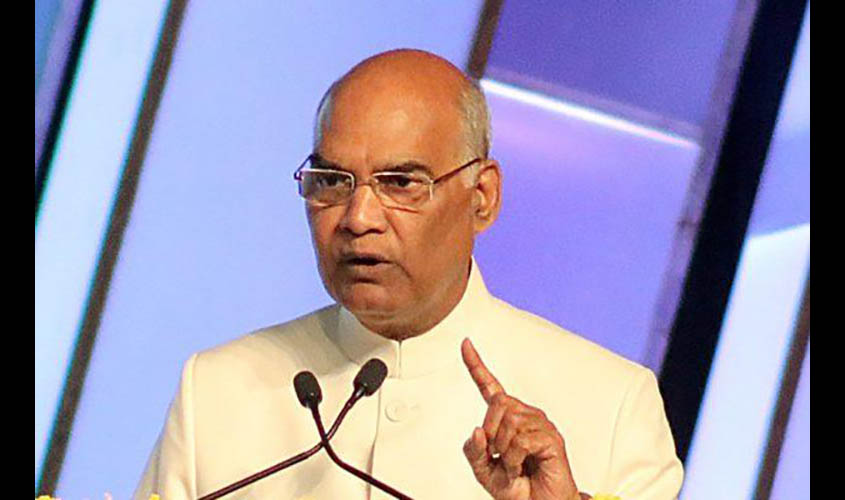As India’s Head of State, President Kovind not only has acquitted himself well, but also set some precedents.
Succeeding a distinguished predecessor is an onerous task. More so if the predecessor be Pranab Mukherjee. In the year that has passed since the change of India’s Head of State, Ram Nath Kovind not only has acquitted himself well, but also set some precedents.
Dr Sarvepalli Radhakrishnan, who succeeded Dr Rajendra Prasad in 1962, was an eminent scholar of international repute. Dr Zakir Hussain, who followed Dr Radhakrishnan, too was an eminent educationist. His death in office changed the paradigm, with V. V. Giri romping home in an election which marked a watershed in India’s politics. Since then Rashtrapati Bhavan has been occupied by politicians, with the sole exception of Dr A. P. J. Abdul Kalam. Pranab Mukherjee was the first politician of high stature to serve as Rashtrapati since Dr Rajendra Prasad.
The selection of Kovind took everyone by surprise. Unlike his predecessors, he had not been a big name in New Delhi’s establishment till then. Dr Zakir Hussain had served as Kovind’s predecessor in the Patna Raj Bhavan (as Governor of the then composite Bihar state) before moving to New Delhi as Vice President in 1962. Perhaps it was keeping with the new paradigm of a Prime Minister who had not served in New Delhi earlier that the office of the President also went to an “outsider”.
The new presidency quietly ushered in changes. Rashtrapati is the Visitor or Chancellor of almost 145 universities. Previously an annual jamboree of Vice Chancellors was held for tokenism. Kovind, who had travelled from his rural moorings in Paraunkh nearly 70 km to Kanpur for his studies, has assigned high priority to education. In the past year, Rashtrapati Bhavan has hosted eight meetings attended by 20 university heads each to discuss problems. Universities have been divided into synergic groups—IITs and technical institutions had one meeting; universities with similar characteristics were clubbed for these interactions where the Ministry of Human Resource Development was proactive. As MP, Kovind had allocated MPLADS funds for building rural schools. His endeavour for better rural infrastructure in education continues. He wants the universities in India to prepare the youth for the “Fourth Industrial Revolution” with emphasis on robotics, genomics and artificial intelligence.
During his career as a lawyer Kovind was active in free legal aid. As President in his speeches he has been appealing to lawyers and medical practitioners to make their talent available “both to those who can afford your fees and also to those who are less fortunate and cannot”. At the National Law Day meet, while praising free legal aid, he said, “it is important to institutionalise this mechanism rather than leave it to the goodness of the individual”.
In these days of Parliament and legislatures being disrupted, his comment at the 60th anniversary of the Vidhan Soudha in Bengaluru is a beacon: “We are aware of the three Ds of the legislature, that it is a place to debate, dissent and finally decide. And if we add a fourth D, decency, only then does the fifth D, namely democracy, become a reality.”
The intrinsic conflict between the judiciary, the legislature and the executive was addressed by Kovind in his speech at Constitution Day, 26 November 2017. He said that while upholding respective autonomy, the three branches “should be careful not to disturb the fraternity of separation of powers by even unknowingly intruding into the domain of either of the two other branches”, and called for sobriety and discretion in the communication between these branches to “reassure the ordinary citizen that the Constitution is safe—and in mature hands”.
Like his predecessors, Kovind has kept himself above party politics. At a time when BJP was protesting against Tipu Sultan in Karnataka, at the Vidhan Soudha anniversary in October, Kovind said, “Tipu Sultan died a heroic death fighting the British. He was also a pioneer in the development and the use of Mysore rockets in warfare. This technology was later adopted by the Europeans”. In Kochi he praised the performance of CPI(M) Chief Minister Pinarayi Vijayan. After his interaction with Mamata Banerjee in Kolkata the Trinamool CM described Kovind as a “good man who will respect the Constitution”. A painting by Mamata Banerjee presented by her now hangs on the walls of the Rashtrapati Bhavan. In the past year, Kovind has met all major political leaders including Rahul Gandhi. Sonia Gandhi is the sole exception to this list.
Kovind has made ten foreign visits including to five countries where previously neither President nor Prime Minister had visited: Djibouti, Equatorial Guyana, Madagascar, Surinam and Swaziland. He is the first Indian leader to visit Cuba in the post Castro era. He arrived from Cuba after a long flight on 24 June and at nine next morning was at the Rashtrapati Bhavan forecourt to receive the President of Seychelles. V.V. Giri had made six trips in a year—Kovind has set a higher benchmark for his successors.
The “At Home” on Independence Day and Republic Day used to be an occasion when many fixers managed to mingle with movers and shakers. The list of 2,347 of Pranab Mukherjee era was pruned to 724 on 26 January. Toppers of CBSE, ISC exams and similar achievers replaced New Delhi’s fixers on Rashtrapati Bhavan lawns. Perhaps the presidency of “unknown” Kovind will throw up opportunity for lesser known but effective citizens.

